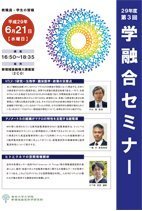AY2017 3rd Gakuyugo Seminar
- Date&Time:
- Jun 21, 2017 16:50~18:35
- Venue:
- Large Lecture Room (2C0), New Frontier Science Bldg.

HTLV-1 Research - The Intersection of Biology, Clinical Medicine, and Policy
Professor Kaoru UchimaruAdult T-cell leukemia (ATL) is caused by infection with the HTLV-1 virus. Japan has about one million infected people and is one of the most highly infected areas in the world. On the other hand, only about 5% of them will develop ATL in their lifetime, and the annual number of cases is about 1,100 nationwide, making it a typical rare cancer. From a policy perspective, we need to take a different view of the large number of infected people and the rare cases. So why do 5% of cases develop the disease? What is going on in the infected cells? Virological and molecular biological investigations are underway. In this seminar, the current status of HTLV-1 infection will be introduced from various perspectives.

Nanometer-scale organization governs macroscopic properties of superconductivity
Visiting Professor Naka Ichinose
NbTi superconducting wire, which is a practical superconducting wire used in MRI and other applications, can now be used as a practical wire by controlling the microstructure at the nanometer level, and the critical current density of high-temperature superconducting material, which was discovered in 1986, has been greatly improved by controlling the microstructure at the nanometer level as well. We will introduce the microstructure control and critical current characteristics of superconducting materials.

Spatial information analysis of humans and vehicles
Lecturer Takahiko KusakabeRecent advances in various sensor technologies and information and communication technologies such as the Internet of Things (IoT) are making it possible to acquire large-scale data on the movement of people and vehicles in cities and regions. We will take a bird's eye view of the latest technologies that use such dynamic spatial information to analyze people's mobility-related behavior.
*The contents of this page were developed based on a machine translation.

